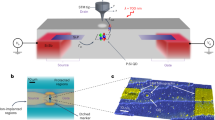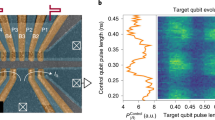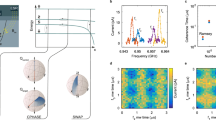Abstract
The ultimate miniaturization of electronic devices will probably require local and coherent control of single electronic wavefunctions. Wavefunctions exist within both physical real space and an abstract state space with a simple geometric interpretation: this state space—or Hilbert space—is spanned by mutually orthogonal state vectors corresponding to the quantized degrees of freedom of the real-space system. Measurement of superpositions is akin to accessing the direction of a vector in Hilbert space, determining an angle of rotation equivalent to quantum phase. Here, we show that an individual atom inside a designed quantum corral1 can control this angle, producing arbitrary coherent superpositions of spatial quantum states. Using scanning tunnelling microscopy and nanostructures assembled atom-by-atom2, we demonstrate how single spins and quantum mirages3 can be harnessed to image the superposition of two electronic states. We also present a straightforward method to determine the atom path enacting phase rotations between any desired state vectors. A single atom thus becomes a real-space handle for an abstract Hilbert space, providing a simple technique for coherent quantum-state manipulation at the spatial limit of condensed matter.
This is a preview of subscription content, access via your institution
Access options
Subscribe to this journal
Receive 12 print issues and online access
$259.00 per year
only $21.58 per issue
Buy this article
- Purchase on SpringerLink
- Instant access to full article PDF
Prices may be subject to local taxes which are calculated during checkout




Similar content being viewed by others
References
Crommie, M. F., Lutz, C. P. & Eigler, D. M. Confinement of electrons to quantum corrals on a metal surface. Science 262, 218–220 (1993).
Stroscio, J. A. & Eigler, D. M. Atomic and molecular manipulation with the scanning tunneling microscope. Science 254, 1319–1326 (1991).
Manoharan, H. C., Lutz, C. P. & Eigler, D. M. Quantum mirages formed by coherent projection of electronic structure. Nature 403, 512–515 (2000).
Kouwenhoven, L. & Marcus, C. Quantum dots. Phys. World 11, 35–39 (1998).
Tans, S. J. et al. Individual single-wall carbon nanotubes as quantum wires. Nature 386, 474–477 (1997).
Woodside, M. T. & McEuen, P. L. Scanned probe imaging of single-electron charge states in nanotube quantum dots. Science 296, 1098–1101 (2002).
Eigler, D. M. et al. Information transport and computation in nanometre-scale structures. Phil. Trans. R. Soc. Lond. A 362, 1135–1147 (2004).
Braun, K. F. & Rieder, K. H. Engineering electronic lifetimes in artificial atomic structures. Phys. Rev. Lett. 88, 096801 (2002).
Rossi, E. & Morr, D. K. Spatially dependent Kondo effect in quantum corrals. Phys. Rev. Lett. 97, 236602–236604 (2006).
Walls, J. D. & Heller, E. J. Spin–orbit coupling induced interference in quantum corrals. Nano Lett. 7, 3377–3382 (2007).
Duan, L. M., Cirac, J. I. & Zoller, P. Geometric manipulation of trapped ions for quantum computation. Science 292, 1695–1697 (2001).
Zanardi, P. & Lloyd, S. Topological protection and quantum noiseless subsystems. Phys. Rev. Lett. 90, 067902 (2003).
Crommie, M. F., Lutz, C. P. & Eigler, D. M. Imaging standing waves in a two-dimensional electron gas. Nature 363, 524–527 (1993).
Tersoff, J. & Hamann, D. R. Theory of the scanning tunneling microscope. Phys. Rev. B 31, 805–813 (1985).
Aligia, A. A. Many-body theory of the quantum mirage. Phys. Rev. B 64, 121102 (2001).
Porras, D., Fernández-Rossier, J. & Tejedor, C. Microscopic theory for quantum mirages in quantum corrals. Phys. Rev. B 63, 155406 (2001).
Schmid, M. & Kampf, A. P. Mirages, anti-mirages, and further surprises in quantum corrals with non-magnetic impurities. Ann. Phys. (Leipzig) 12, 463–470 (2003).
Aligia, A. A. & Lobos, A. M. Mirages and many-body effects in quantum corrals. J. Phys. Condens. Matter 17, S1095–S1122 (2005).
Heller, E. J., Crommie, M. F., Lutz, C. P. & Eigler, D. M. Scattering and absorption of surface electron waves in quantum corrals. Nature 369, 464–466 (1994).
Fiete, G. A. et al. Scattering theory of Kondo mirages and observation of single Kondo atom phase shift. Phys. Rev. Lett. 86, 2392–2395 (2001).
Fiete, G. A. & Heller, E. J. Colloquium: Theory of quantum corrals and quantum mirages. Rev. Mod. Phys. 75, 933–948 (2003).
Agam, O. & Schiller, A. Projecting the Kondo effect: Theory of the quantum mirage. Phys. Rev. Lett. 86, 484 (2001).
Correa, A., Hallberg, K. & Balseiro, C. A. Mirages and enhanced magnetic interactions in quantum corrals. Europhys. Lett. 58, 899 (2002).
Rahachou, A. I. & Zozoulenko, I. V. Elastic scattering of surface electron waves in quantum corrals: Importance of the shape of the adatom potential. Phys. Rev. B 70, 233409 (2004).
Knorr, N., Schneider, M. A., Diekhoner, L., Wahl, P. & Kern, K. Kondo effect of single Co adatoms on Cu surfaces. Phys. Rev. Lett. 88, 096804 (2002).
Lin, C. Y., Castro Neto, A. H. & Jones, B. A. Microscopic theory of the single impurity surface Kondo resonance. Phys. Rev. B 71, 35417 (2005).
Eriksson, M. A. et al. Cryogenic scanning probe characterization of semiconductor nanostructures. Appl. Phys. Lett. 69, 671–673 (1996).
Topinka, M. A. et al. Imaging coherent electron flow from a quantum point contact. Science 289, 2323–2326 (2000).
Fallahi, P. et al. Imaging a single-electron quantum dot. Nano Lett. 5, 223–226 (2005).
Kuhl, U., Persson, E., Barth, M. & Stöckmann, H.-J. Mixing of wavefunctions in rectangular microwave billiards. Eur. Phys. J. B 17, 253–259 (2000).
Gokirmak, A., Wu, D.-H., Bridgewater, J. S. A. & Anlage, S. M. Scanned perturbation technique for imaging electromagnetic standing wave patterns of microwave cavities. Rev. Sci. Instrum. 69, 3410–3417 (1998).
Crampin, S. Electron states in quantum corrals. Phil. Trans. R. Soc. Lond. A 362, 1149–1161 (2004).
Acknowledgements
This work was supported by the US Office of Naval Research, the US National Science Foundation, the US Department of Energy, the Research Corporation and the Stanford-IBM Center for Probing the Nanoscale. We acknowledge the US NDSEG program (C.R.M.) and the Alfred P. Sloan Foundation (H.C.M.) for fellowship support during this project. We thank D.-H. Lee, B. Sundaram, A. Bernevig, D. Haldane and D. Eigler for discussions and W. Mar for technical assistance.
Author information
Authors and Affiliations
Corresponding author
Supplementary information
Supplementary Information
Supplementary Figures 1–2 (PDF 201 kb)
Supplementary Information
Supplementary Movie 1 (MOV 7599 kb)
Supplementary Information
Supplementary Movie 2 (MOV 4850 kb)
Rights and permissions
About this article
Cite this article
Moon, C., Lutz, C. & Manoharan, H. Single-atom gating of quantum-state superpositions. Nature Phys 4, 454–458 (2008). https://doi.org/10.1038/nphys930
Received:
Accepted:
Published:
Issue Date:
DOI: https://doi.org/10.1038/nphys930



